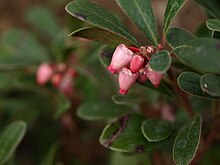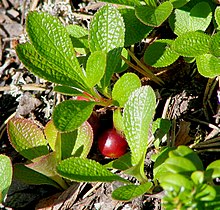Bearberry


Bearberriesare three species of dwarfshrubsin the genusArctostaphylos.Unlike the other species ofArctostaphylos(seemanzanita), they are adapted toArcticandsubarctic climates,and have a circumpolar distribution in northernNorth America,AsiaandEurope.

Etymology[edit]
The genus name,Arctostaphylos,derives from theGreekarctos( "bear" ) andstaphylos( "bunch of grapes" ).[1]The species name,uva-ursi,is from theLatinuva,( "bunch of grapes" ) andursus( "bear" ), leading to the common name, "bearberry".[1]
In the culture ofFirst Nations people of Canada,the plant is calledkinnikinnick,from anAlgonquian(possibly aBlackfoot) word for "smoking mixture".[1]
Description[edit]
Bearberries grow as low-lying shrubs in soils predominantly composed of sand, gravel, or dunes in theboreal forest.It is less common north of thetree line.[1]
The plant has flexible branches growing up to 2 metres (6 ft 7 in) long covered with red, shredded bark and dark green, oval leaves.[1]Flowers are white or pink, tipped with red, growing in small clusters at the ends of branches, and later maturing into red oval fruits.[1]
Species[edit]
The name "bearberry" for the plant derives in part from the edible fruit which is a food forbears.[2]The fruits are gathered as food for humans, and the leaves are used in indigenousherbal medicine.[1]
Thealpine bearberryArctostaphylos alpina(L.) Spreng (syn.Arctous alpinus(L.) Niedenzu) is a procumbent shrub 10–30 cm high (3.9–11.8 in). Berries are dark purple to black. Its distribution is in northern latitudes fromScotlandeast acrossScandinavia,Russia,Alaska,CanadaandGreenland;southern limits extend into Europe in thePyreneesand theAlps,in Asia to theAltay Mountains,and in North America toBritish Columbiain the west, andMaineandNew Hampshirein theUnited Statesin the east.
Thered bearberryArctostaphylos rubra(Rehd. & Wilson) Fernald (syn.Arctous rubra(Rehder and E.H. Wilson) Nakai;Arctous alpinusvar.ruberRehd. and Wilson) is a procumbent shrub 10–30 cm high (3.9–11.8 in) with deciduous leaves. Berries are red. Its distribution is in the mountains ofSichuan,southwesternChinanorth and east to easternSiberia,Alaskaand northernCanada,east to northernQuebec.
Uses[edit]

The berries ripen late in summer and can be eaten raw.[3]
The plant contains diversephytochemicals,includingursolic acid,tannic acid,gallic acid,someessential oilsandresin,hydroquinones(mainlyarbutin,up to 17%),tannins(up to 15%),phenolic glycosidesandflavonoids.[1][better source needed]
Native American Indians traditionally made use of the plant's leaves, which they gathered in summer and dried for use as atobaccosubstitute or mixed with tobacco.[4]
Folk medicine[edit]
The dried leaves can be used in teas, liquid diffusions, tea bags or tablets fortraditional medicine.[5]Bearberry appears to be relatively safe, although large doses may causenausea,vomiting,fever,chills, back pain andtinnitus.[6]Cautions for use apply during pregnancy, breast feeding, or in people withkidney disease.[5][7]
The efficacy and safety of bearberry treatment in humans remain unproven,[6]as noclinical trialsexist to interpret effects on any disease.
History and folklore[edit]
Bearberry was first documented inThe Physicians of Myddfai,a 13th-centuryWelshherbal.It was also described byClusiusin 1601, and recommended for medicinal use in 1763 byGerhardand others. It first appeared in the London Pharmacopoeia in 1788.[citation needed]
Native Americansuse bearberry leaves withtobaccoand other herbs in religious ceremonies, both as a smudge (type of incense) or smoked in a sacred pipe carrying the smoker's prayers.[1]Among the ingredients in kinnikinnick were non-poisonoussumacleaves,[8]and the inner bark of certain bushes such asred osier dogwood (silky cornell),[8]chokecherry,andalder,to improve the taste of the bearberry leaf.[9]
References[edit]
- ^abcdefghiBeryl Hallworth (March 4, 2015)."Bearberry".The Canadian Encyclopedia.Retrieved2020-03-19.
- ^Janice J. Schofield (1989).Discovering wild plants: Alaska, western Canada, the Northwest.Alaska Northwest Books. p. 217.ISBN978-0-88240-355-7.
- ^Lyons, C. P.(1956).Trees, Shrubs and Flowers to Know in Washington(1st ed.). Canada: J. M. Dent & Sons. p. 196.
- ^Kephart, H.(1916).Camping and Woodcraft; A Handbook for Vacation Campers and for Travelers in the Wilderness.Vol. 2 (18 ed.). New York: The Macmillan Company. pp. 401–402.OCLC2191524.(reprinted in 1957)
- ^abBlumenthal M (translation from German) (1998).Therapeutic Guide to Herbal Medicines.American Botanical Council.ISBN978-0-9655555-0-0.
- ^abAllen C. Bowling (2006).Complementary and Alternative Medicine and Multiple Sclerosis.Demos Medical Publishing. p. 127.ISBN978-1-932603-54-5.
- ^Nordeng H. and Havnen, G.C. (2005) "Impact of socio-demographic factors, knowledge and attitude on the use of herbal drugs in pregnancy"Acta Obstetricia et Gynecologica Scandinavica84(1): pp. 26–33, note 16,doi:10.1111/j.0001-6349.2005.00648.x
- ^abUpham, Warren (2001).Minnesota Place Names: A Geographical Encyclopedia.Minnesota Historical Society Press. p. 481.ISBN978-0-87351-396-8.
- ^Staff (2009)"Bearberry"Archived2010-12-18 at theWayback MachineDiscovering Lewis and ClarkThe Lewis and Clark Fort Mandan Foundation
External links[edit]
- European Medicines Agency, Committee on Herbal Medicinal Products (HMPC) (30 January 2018).Assessment report on Arctostaphylos uva-ursi (L.) Spreng., folium,London
